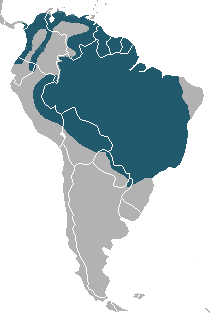| Bush dog[1] | |
|---|---|

| |
| Bush dog at Prague Zoo | |
| Scientific classification | |
| Domain: | Eukaryota |
| Kingdom: | Animalia |
| Phylum: | Chordata |
| Class: | Mammalia |
| Order: | Carnivora |
| Infraorder: | Cynoidea |
| Family: | Canidae |
| Subfamily: | Caninae |
| Tribe: | Canini |
| Genus: | Speothos |
| Species: | S. venaticus
|
| Binomial name | |
| Speothos venaticus (Lund, 1842)
| |
| Subspecies | |
| |

| |
| Bush dog range | |
The bush dog (Speothos venaticus) is a canine found in Central and South America.[1][2] In spite of its extensive range, it is very rare in most areas except in Suriname, Guyana and Peru;[2][4] it was first described by Peter Wilhelm Lund from fossils in Brazilian caves and was believed to be extinct.[4]
The bush dog is the only living species in the genus Speothos,[1] and genetic evidence suggests that its closest living relative is the maned wolf of central South America[5] or the African wild dog.[6] The species is listed as Near Threatened by the IUCN.[7][8][9]
In Brazil, it is called cachorro-vinagre ('vinegar dog') and cachorro-do-mato ('bush dog'). In Spanish-speaking countries, it is called perro vinagre ('vinegar dog'), zorro vinagre ('vinegar fox'), perro de agua ('water dog'), and perro de monte ('shrub or woodland dog').
- ^ a b c Wozencraft, W. C. (2005). "Order Carnivora". In Wilson, D. E.; Reeder, D. M. (eds.). Mammal Species of the World: A Taxonomic and Geographic Reference (3rd ed.). Johns Hopkins University Press. ISBN 978-0-8018-8221-0. OCLC 62265494.
- ^ a b c DeMatteo, K.; Michalski, F.; Leite-Pitman, M. R. P. (2011). "Speothos venaticus". IUCN Red List of Threatened Species. 2011: e.T20468A9203243. doi:10.2305/IUCN.UK.2011-2.RLTS.T20468A9203243.en. Retrieved November 19, 2021.
- ^ "Appendices". CITES. Retrieved January 14, 2022.
- ^ a b Cite error: The named reference
Beiseigel2005was invoked but never defined (see the help page). - ^ Wayne, R. K.; et al. (1997). "Molecular systematics of the Canidae". Systematic Biology. 46 (4): 622–653. doi:10.1093/sysbio/46.4.622. PMID 11975336.
- ^ Nyakatura, K.; et al. (2012). "Updating the evolutionary history of Carnivora (Mammalia): a new species-level supertree complete with divergence time estimates". BMC Biology. 10 (12): 12. doi:10.1186/1741-7007-10-12. PMC 3307490. PMID 22369503.
- ^ Beisiegel, B.M. (2009), "First camera trap record of bush dogs in the state of Sao Paulo, Brazil" (PDF), Canid News, vol. 12, no. 5, S2CID 41021664, retrieved March 12, 2024
- ^ Heft, Jeremy (June 12, 2021). "How Do Dogs Help With Bush Dog Conservation". WolfCenter.org. Wolf Education and Research Center. Retrieved April 2, 2023.
- ^ DeMatteo, Karen. "Using a survey of carnivore conservationists to gain new insight into the ecology and conservation status of the bush dog" (PDF). Canids.org. SSC Canid Specialist Group. Retrieved April 2, 2023.
